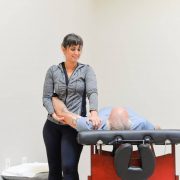New Year — New You — New Pain?
New year, new you, right?
We’re officially in 2019 and it’s a brand new start… You’re excited, you’re motivated, and you’re on your way to achieving your goals for the year. But what happens when back pain hits you? Or your knee starts to hurt? Or your hip starts bothering you? The last thing you want is for your new routine to be disrupted and your progress halted…
So how do you know if the pain you’re experiencing is something to really worry about, or if it’s just a result of your body adjusting to a more active routine? (related: Where is your pain really coming from?)
These FOUR questions will help you clarify the type of pain you’re dealing with, help you figure out what to do about it, and most importantly – prevent “new pains” from getting in the way of your goals in the new year!
1. Does your pain come and go?
If the pain comes and goes, and starts to decrease the more you improve your fitness level, it’s probably just a sign that your body is getting used to your new activities. For example, if you’ve started doing squats for the first time and notice some knee pain when you first begin, you shouldn’t worry unless the pain gets progressively worse as you exercise.
Best practice: Keep an eye on this kind of pain – or download one of our FREE GUIDES – but there’s no urgent need to run to the doctor.
2. Does the pain last after the activity but go away the next day?
If your pain follows a pattern — e.g., your knee pain stays with you for the rest of the day after doing your squat sets but is gone when you wake up the next morning — means your body is trying to tell you something. This type of recurrent pattern is a warning sign that your body isn’t responding correctly to the exercise and could start to incur damage. If you’re experiencing a similar phenomenon, now is the time to make an appointment with a specialist physical therapist. Going to the doctor or orthopedic surgeon would be a less productive path to take, as they will likely send you down a rabbit hole of unnecessary tests and procedures (Do you really need an MRI?). But meeting with a physical therapist before the problem becomes too serious can help you adjust your movement and strengthen the right muscles so that you’re able to continue exercising as planned.
Best practice: Talk to a physical therapy specialist who can analyze your movement and the source of your pain.
3. Is the pain causing you to move differently?
People who ignore pain without seeing a physical therapist often end up here, which leads to a more difficult recovery. They often end up limping, walking “crooked,” modifying movements such as bending over, and moving stiffly. This is a result of your body compensating for the pain initially triggered by the exercise. Such compensations start to cause wear and tear on other areas, which only create more problems down the road. If you’ve hit this phase – it’s still not too late to get some help. Working directly with a physical therapy specialist will help you to quickly get rid of your pain and correct the compensations you’ve started to develop – so they don’t get worse.
Best practice: Make an appointment with a physical therapy specialist (at our office your first one is FREE)
4. Is your pain causing you to avoid or stop doing something?
When your pain is stopping you from doing something — whether that be doing squats, running, or picking things up off the floor— it’s a sign that your body is in distress and needs help from a physical therapy specialist, orthopedic specialist, or your doctor. However, I encourage people to seek out a physical therapist first. Traditional doctors typically don’t perform movement tests, relying solely on imaging and procedures to make diagnoses. They’re also more likely to prescribe rest, surgery, or painkillers — despite the fact that 80-90% of ALL aches and pains can be resolved through corrective exercise and movement strategies administered by a movement expert (such as a specialist physical therapist). If the problem does require further intervention, then a physical therapist can refer you to the appropriate medical specialist. Most states (including NH) don’t require a prescription to see a physical therapist. You can give us a call and come straight in!
Best practice: See if physical therapy can help FIRST by talking to a specialist and getting an evaluation
The moral of the story is, don’t wait to ask for help! You’re better off being extra-careful and addressing your pain early than waiting for it to become a full blown injury. If you are experiencing pain and/or need any help staying on track with your new movement program, don’t hesitate to reach out! You can also find us on Facebook and Instagram and learn more about our services here.
Happy New Year!


